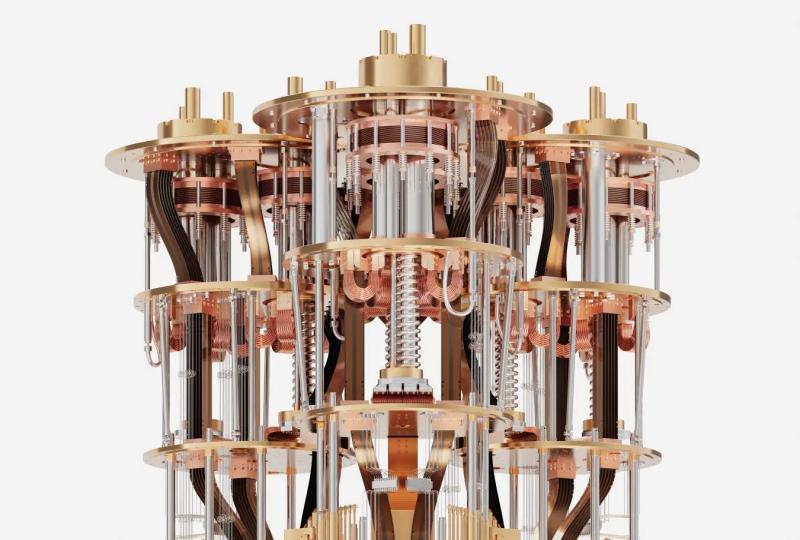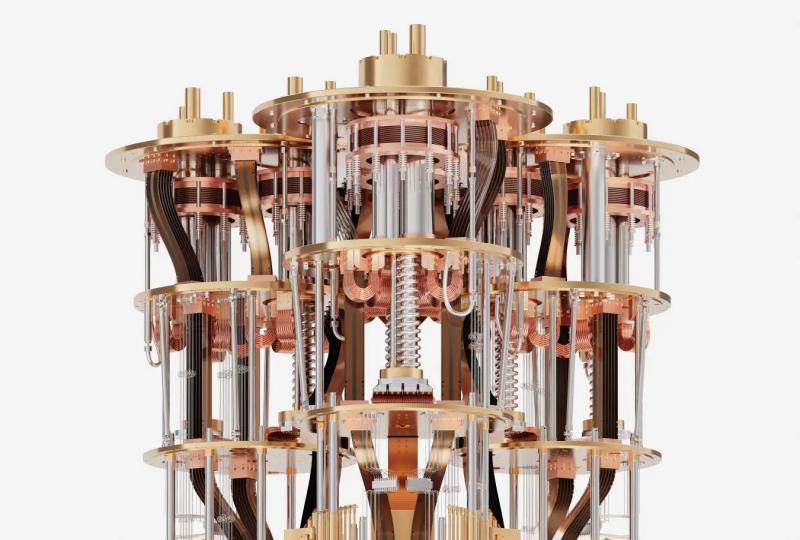Top 10 Breakthroughs in Integrated Quantum Control Technology
2025.08.08 · Blog Integrated Quantum Control Technology
Integrated quantum control represents the convergence of control electronics and quantum hardware into a singular, efficient, and scalable solution. Traditionally, quantum computers relied on bulky, room-temperature control systems located outside the cryogenic environment, connected via a tangled web of wires. These setups introduced latency, errors, and practical scaling limits.
By embedding control elements such as RF generators, DACs, and FPGA logic onto the same chip or substrate as qubits, scientists have reduced signal degradation, minimized latency, and enhanced scalability. This innovation forms the backbone of modern quantum architectures, particularly in systems like SpinQ’s portable quantum computers, which rely on compact and robust designs.
At SpinQ, integrated quantum control aligns perfectly with the company’s mission—bringing quantum computing out of the lab and into classrooms, industries, and everyday applications.
Understanding the Foundations of Quantum Control
Quantum control, at its core, refers to the manipulation of quantum systems (like qubits) using external fields, pulses, and feedback loops. These operations enable the execution of logic gates, initialization, readout, and error correction. Without accurate control, even the most advanced qubit would be no more useful than a random number generator.
Integrated systems take this a step further by embedding the control within the quantum processor itself, eliminating the distance between controller and controlled. This integration leads to more deterministic behavior, increased coherence times, and seamless coordination between qubits.
Why Quantum Systems Need Control Precision
Precision in quantum control is critical for gate fidelity, noise suppression, and maintaining qubit coherence. Qubits are extremely sensitive to environmental fluctuations and require finely tuned electromagnetic pulses for accurate manipulation.
An integrated quantum control system offers unmatched accuracy due to its proximity and synchronization. Pulse shaping, timing, and adaptive feedback can all be handled faster and more precisely—something that's vital when executing quantum algorithms with thousands or millions of gate operations.
The Shift from External to Integrated Control Systems
Historically, quantum systems used rack-mounted electronics, signal generators, and waveform synthesizers. While functional for a handful of qubits, they quickly became unmanageable beyond small-scale demonstrations.
The turning point came when researchers realized that classical electronics could be scaled down and co-fabricated with quantum devices. Today, we see integrated quantum control used in leading-edge superconducting processors, such as those developed by Google and IBM. SpinQ is bringing similar concepts to accessible, educational, and commercial platforms.
Hardware Design in Integrated Quantum Control
At the heart of integrated systems is a smart hardware design. This includes custom ASICs (application-specific integrated circuits), FPGAs (field-programmable gate arrays), and cryogenic-compatible chips. These components are strategically placed to minimize path length and electromagnetic interference.
Cryogenic-compatible electronics are key enablers here. They operate at near-zero temperatures, where quantum bits function optimally. Embedding such control units requires careful thermal design, power management, and signal integrity planning.
Role of Cryogenic Control Systems
Cryogenic environments are where quantum magic happens. But integrating control electronics into these environments presents a unique set of engineering challenges. Power dissipation, thermal isolation, and material compatibility must be finely balanced.
Nonetheless, significant strides have been made. Companies are now developing cryo-CMOS and cryo-FPGA platforms that not only survive but thrive in extreme cold, allowing integrated quantum control systems to flourish in their native habitat.
Chip-Level Integration with Qubits
Integrating control electronics at the chip level reduces latency, enhances speed, and opens doors to new quantum circuit architectures. By placing DACs, filters, mixers, and amplifiers directly alongside qubits, system designers can eliminate unnecessary cabling and interference.
Such integration enables fast gate execution, lower error rates, and the potential for reconfigurable control based on real-time feedback. In SpinQ’s Gemini and Triangulum systems, similar principles are applied to build compact yet powerful quantum computing models suitable for training and real-world problem-solving.
Enabling Scalable Quantum Computers
Scalability is a holy grail in quantum computing. A few dozen qubits are interesting, but useful quantum advantage may demand thousands or even millions. Integrated quantum control is one of the only realistic paths to achieve this.
Reducing the number of external wires, improving signal fidelity, and minimizing control delays allow for better inter-qubit connectivity and denser architectures. SpinQ’s vision embraces this future with portable devices that retain simplicity without sacrificing control quality.
Overcoming Classical Wiring Bottlenecks
Traditional wiring between control electronics and qubits limits quantum systems. Every wire adds thermal load, increases cross-talk, and consumes physical space. Integrated systems remove much of this burden by embedding control logic and routing inside the processor package itself.
This doesn’t just reduce the mess—it transforms how scalable and compact a quantum computer can be.
Noise Reduction in Integrated Systems
Noise is the enemy of quantum coherence. Whether from thermal, electronic, or electromagnetic sources, it introduces errors that are hard to correct. Integrated quantum control significantly cuts down noise pathways by minimizing travel distance and using cryo-optimized materials.
Moreover, smarter control systems can dynamically adapt to environmental changes, ensuring that qubits stay “in tune” for longer durations.
Boosting Fidelity and Reducing Error Rates
Quantum gate fidelity directly affects the success of computations. With integrated quantum control, gate errors can be reduced by optimizing timing, reducing signal reflections, and using higher-resolution control pulses. This leads to fewer retries, better data integrity, and more efficient quantum programs.
For companies like SpinQ, where accessibility is key, high fidelity ensures even entry-level devices perform complex tasks with measurable success.
Timing Accuracy and Synchronization Benefits
In quantum computing, timing isn't just important—it's everything. Qubit interactions happen at the nanosecond scale, and any mismatch in control pulse arrival times can result in failed operations. Integrated control allows for ultra-precise synchronization since everything is clocked from a single source close to the action.
By aligning signals more tightly, operations become more repeatable and efficient.
Real-Time Feedback Loops in Quantum Experiments
Real-time feedback enables adaptive quantum computing—correcting errors, optimizing performance, or even altering computation paths based on partial results. This is only feasible when control systems are fast, local, and intelligent.
Integrated control facilitates these loops by reducing the need for signals to travel long distances. Quantum experiments become more interactive, more intelligent, and ultimately more useful.
Integration with Superconducting Qubits
Superconducting qubits are among the most popular qubit types due to their scalability and performance. However, they are highly sensitive and require precise microwave control.
Integrated systems, designed to work at cryogenic temperatures and deliver high-frequency signals with minimal distortion, are perfectly suited for such platforms. Companies like SpinQ leverage these technologies in their advanced processor models.
Adaptability for Trapped Ions and Photonic Qubits
While integration is natural with superconducting systems, other modalities like trapped ions and photonic qubits are also benefiting. Custom chipsets for optical and electromagnetic control signals can be embedded into experimental setups.
This adaptability ensures integrated quantum control isn’t limited to one branch of quantum computing—it’s a universal enabler.
Applications in Quantum Education Systems
Education demands devices that are robust, simple, and affordable. SpinQ’s line of educational quantum computers exemplifies how integrated control streamlines device architecture, reduces maintenance, and ensures reproducibility.
Students benefit from real hands-on experience without needing to navigate complex hardware setups. Quantum becomes more approachable, and curiosity can thrive.
Integrated Control in Portable Quantum Devices
Portability is the hallmark of SpinQ's mission. Integrated control is what makes that portability possible. Without it, cooling systems, external controls, and wiring would make compact devices unfeasible.
From SpinQ Gemini to future innovations, this embedded approach ensures that quantum computing can leave the lab and enter the classroom, the office, and even the field.
Use Cases in Academic Research
Researchers need flexible, programmable, and scalable control platforms. Integrated quantum control gives them tools to explore new algorithms, study error correction techniques, and prototype novel quantum devices—all without needing a room full of electronics.
As quantum technology enters a golden age, such integration will become a staple in academic innovation.
Role in Quantum-as-a-Service Platforms
In the cloud era, quantum-as-a-service (QaaS) is becoming the preferred access model. Integrated quantum control allows providers to maintain compact, reliable, and remotely manageable systems.
This not only reduces operational costs but ensures that performance is consistent for all users, regardless of location.
Commercial Quantum Processors and Control Units
Commercial deployment means reliability, cost-efficiency, and ease of use. Integrated control makes processors more durable, simplifies maintenance, and lowers production complexity.
SpinQ is one of the few companies driving this vision for the commercial market with products that balance sophistication and accessibility.
AI-Driven Quantum Control Mechanisms
Machine learning and AI are being used to optimize control pulses, error correction strategies, and system configurations. With integrated platforms, AI models can run close to the quantum hardware, enabling rapid experimentation and adaptation.
This synergy promises a smarter generation of quantum computers—ones that learn and optimize themselves.
Potential of FPGA and ASIC-Based Controllers
FPGAs and ASICs provide tailored performance, speed, and flexibility. When integrated with quantum processors, they allow for real-time gate compilation, ultra-fast feedback, and power-efficient control.
These components are the brain of integrated quantum control systems—customizable, powerful, and compact.
Low-Latency Interconnects in Integrated Architectures
Reducing latency is a constant goal in computing, and in quantum systems, it’s doubly important. Integrated designs use ultra-short interconnects that ensure fast, interference-free communication between components.
This translates into better performance, tighter gate timings, and smoother algorithm execution.
Power Dissipation in Cryogenic Environments
One of the major challenges is dealing with heat. Quantum systems need cold; electronics generate heat. Integrated quantum control solves this via low-power design, cryo-compatible chips, and advanced materials.
The result? Performance without compromising thermal stability.
Design Constraints and Engineering Barriers
As with any cutting-edge technology, integrated quantum control faces design limitations. Component miniaturization, material compatibility, and signal interference are all hurdles.
Yet, with ongoing research and innovation, these are being tackled methodically—paving the way for widespread adoption.
Energy Efficiency and Miniaturization
Less energy, more performance—sounds like a dream, but that’s what integrated control delivers. With lower signal losses and fewer power-hungry external components, systems are becoming greener and more compact.
That’s good news for both developers and the planet.
Improved Qubit Coherence and Operation Speed
Every nanosecond counts in quantum computing. Integrated control enhances both the coherence time of qubits and the speed of operations. Better synchronization and shorter signal paths mean fewer errors and faster calculations.
Enhanced User Interface for Developers
Developers benefit from better abstraction layers, GUI integration, and programmable control blocks. Integrated systems enable high-level access without sacrificing low-level precision.
SpinQ’s platforms reflect this philosophy—simple interfaces backed by powerful technology.
Quantum Control for Secure Communication
Quantum control doesn’t just power computing—it also underpins secure quantum communication systems. Integrated designs make it easier to deploy QKD (quantum key distribution) systems at scale.
This could be the future of cybersecurity.
Post-Quantum Cryptographic Implementations
As classical cryptography comes under threat, integrated control systems can host quantum-resistant protocols, offer secure authentication layers, and support next-gen encryption standards.
Another example of how control systems go beyond just flipping qubits.
SpinQ’s Innovation in Integrated Quantum Control
SpinQ has pioneered accessible, high-performance quantum computing through compact design and smart integration. From education to research, their use of integrated quantum control sets them apart.
Their products prove that powerful technology doesn’t have to be out of reach.
Frequently Asked Questions
What is integrated quantum control? It refers to embedding control electronics directly into or near quantum processors to improve performance, reduce latency, and enable scalability.
Why is integrated control important in quantum computing? It boosts gate fidelity, minimizes error rates, and supports compact, scalable designs—essential for practical quantum computing.
How does SpinQ use integrated quantum control? SpinQ integrates control into their portable quantum systems, enabling user-friendly, scalable quantum experiences for education and commercial use.
Is integrated quantum control suitable for all qubit types? Yes, with custom adaptation, it can support superconducting, photonic, and trapped-ion systems.
What are the key benefits of integrated control? Improved coherence, faster gate execution, lower noise, reduced power consumption, and greater scalability.
Can integrated control help in quantum education? Absolutely. It simplifies setup, reduces complexity, and makes quantum hardware more accessible to students and teachers.
The Future of Integrated Quantum Control
The future is bright, and integrated quantum control is lighting the path. As quantum systems evolve from experimental novelties to real-world tools, integration will become standard. It offers the keys to unlock practical, scalable, and accessible quantum technologies.
From classrooms to cloud platforms, SpinQ is already living that future. Their commitment to pushing boundaries while keeping accessibility at the core makes them a leader in the quantum control revolution.
Featured Content






